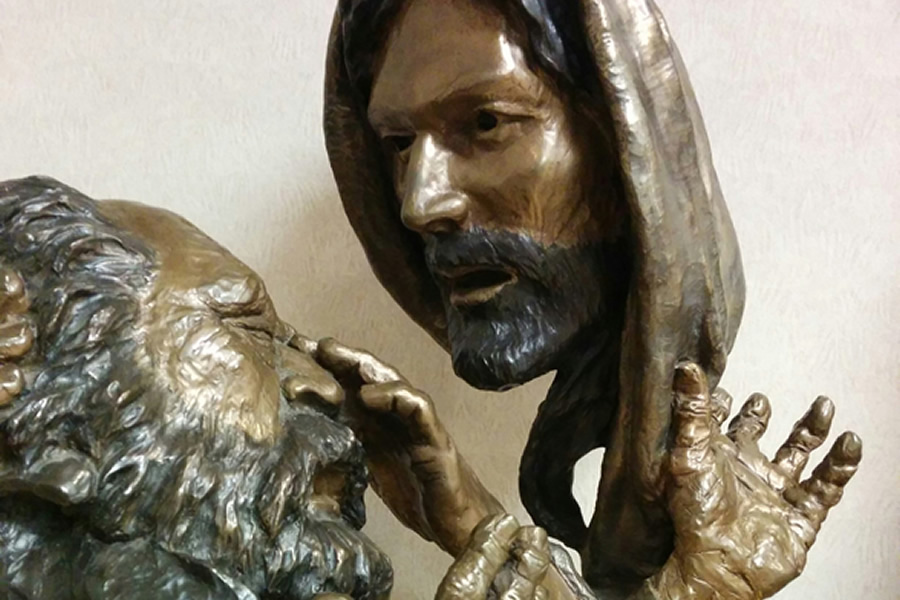
Eyesight to the Blind
03-19-2023Weekly ReflectionDr. Scott HahnGod’s ways of seeing are not our ways, we hear in today’s First Reading. Jesus illustrates this in the Gospel as the blind man comes to see and the Pharisees are made blind.The blind man stands for all humanity. “Born totally in sin,” he is made a new creation by the saving power of Christ.
As God fashioned the first man from the clay of the earth (see Genesis 2:7), Jesus gives the blind man new life by anointing his eyes with clay (see John 9:11). As God breathed the spirit of life into the first man, the blind man is not healed until he washes in the waters of Siloam, a name that means “Sent.” Jesus is the One “sent” by the Father to do the Father’s will (see John 9:4; 12:44). He is the new source of life-giving water: the Holy Spirit who rushes upon us in Baptism (see John 4:10; 7:38–39). This is the Spirit that rushes upon God’s chosen king David in today’s First Reading. A shepherd like Moses before him (see Exodus 3:1; Psalm 78:70– 71), David is also a sign pointing to the good shepherd and king to come—Jesus (see John 10:11). The Lord is our shepherd, as we sing in today’s Psalm. By His death and Resurrection He has made a path for us through the dark valley of sin and death, leading us to the verdant pastures of the kingdom of life, the Church.
In the restful waters of Baptism He has refreshed our souls. He has anointed our heads with the oil of Confirmation and spread the Eucharistic table before us, filling our cups to overflowing. With the once-blind man we enter His house to give God the praise, to renew our vow: “I do believe, Lord.”
“The Lord looks into the heart,” we hear today. Let Him find us, as Paul advises in today’s Epistle, living as “children of light,” trying always to learn what is pleasing to our Father.
A service of the St. Paul Center for Biblical Theology www.SalvationHistory.com.
“ ‘Al pasar vio Jesús a un hombre ciego de nacimiento’... Jesús pasa y se da cuenta en seguida del dolor”. En efecto, así es la lógica de Jesús: nunca permanece indiferente ante las necesidades de las personas con las que se encuentra. Las acciones de Cristo para devolver la vista a este hombre ciego están cargadas de simbolismo. Primero mezcla la tierra con saliva y le unta ese lodo en los ojos. Este gesto recuerda el pasaje del libro del Génesis donde se narra la creación del hombre como una figura de barro a la que el soplo de Dios infunde la vida (Gn 2,7). Jesús, al curar a ese hombre, está llevando a cabo una nueva creación. Este hombre, ciego de nacimiento, va a nacer de nuevo, va a comenzar una nueva vida en cuanto pueda ver.
Luego Jesús le dice que vaya a lavarse en la piscina de Siloé, y ese hombre va, se lava, y recupera la vista. El agua de esa alberca que limpia sus ojos es símbolo del agua bautismal, que nos hace capaces de ver con la luz de la fe. El evangelista hace notar, para los lectores que no sepan hebreo, que Siloé significa “enviado”, pero sobre todo lo hace para señalar que Jesús es ese Enviado de Dios que, cuando se acude a Él, especialmente al configurarse con su muerte y resurrección en las aguas del bautismo, nos hace capaces de ver.
“Con este milagro –enseña el Papa Francisco– Jesús se manifiesta y se manifiesta a nosotros como luz del mundo; y el ciego de nacimiento nos representa a cada uno de nosotros, que hemos sido creados para conocer a Dios, pero a causa del pecado somos como ciegos, necesitamos una luz nueva; todos necesitamos una luz nueva: la de la fe, que Jesús nos ha donado”.
La curación realizada por Jesús suscita una encendida discusión, porque Jesús la realiza en sábado, violando, según los fariseos, el precepto festivo. Esta escena del Evangelio que hoy meditamos nos invita a considerar cuál es nuestra actitud: la de los doctores que, orgullosos, juzgan a los demás, o la de aquel ciego que, consciente de sus necesidades y limitaciones, va secundando lo que Jesús le pide, para abrirse a su gracia y a la luz de la fe.
BACK TO LIST